This inexact crepuscular period known as dawn or twilight serves as mealtime for one of our common summer resident birds, the Common Nighthawk.
The male nighthawk has a bright white throat patch, which is indistinct or absent in the female:

Sunrise is still 25 minutes away, but the cloud tops are illuminated, and this is prime time for nighthawks:
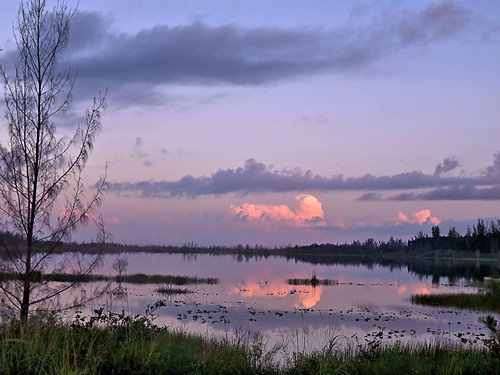
In mid-June, the Planet Mars shone brightly red, alone in the early morning sky, until the rotating Earth "caught up" with the full Moon, shown here about 1/2 hour before sunrise on June 29:
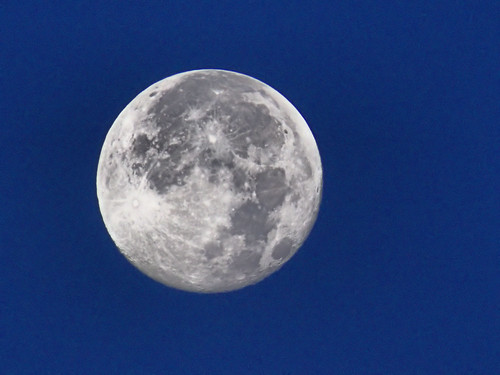
Sunlight had not yet reached the ground when a storm cloud over the Everglades to the west caught the sun's rays. The Moon (now two days past full) appeared against a blue sky just before sunrise:

Sometimes a layer of high clouds reflects the light of the sun nearly an hour before sunrise, or storms darken the early morning or late afternoon sky, at which times nighthawks extend their foraging period.

Inappropriately named, the nighthawk is not a raptor. It "hawks" flying insects with its huge gaping mouth.

It sleeps most of the night like you and me and most other "birds." Its sharp nasal "peenk" call greets our ears as we step out of our front door. Walking along the gravel road, we are startled by a "boom" close overhead as a nighthawk dives down and then turns sharply upward.
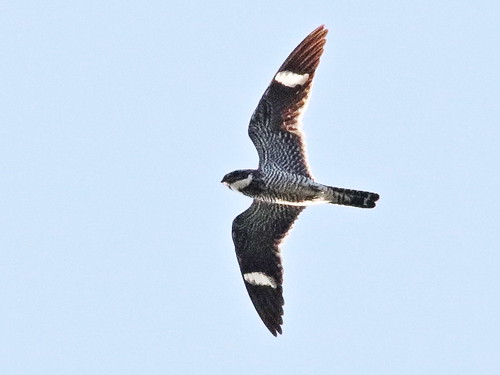
During the day, nighthawks rest on the ground or roost longitudinally on tree branches or utility wires:
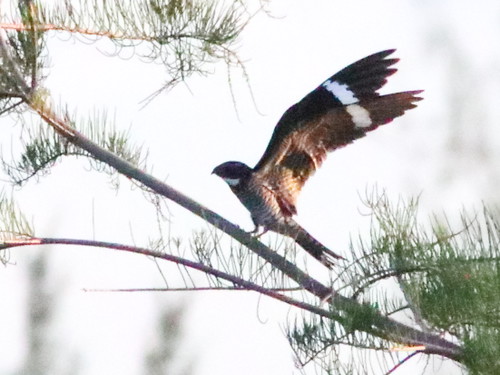
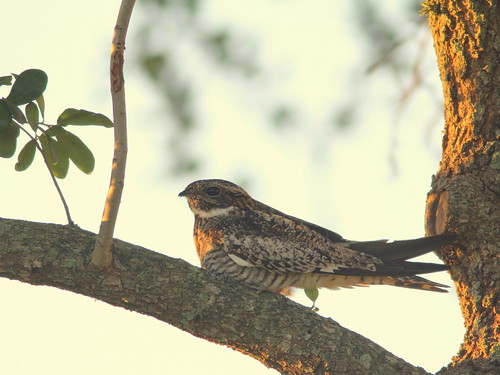
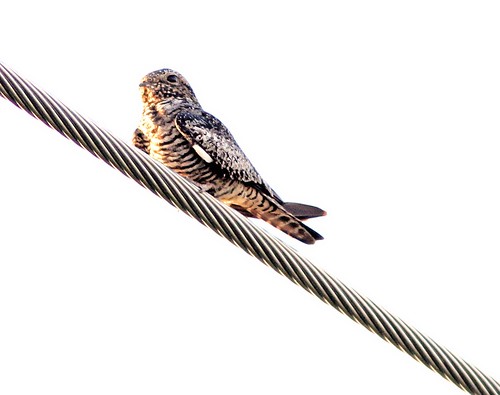
Rarely, one will perch crosswise as do "normal" birds:
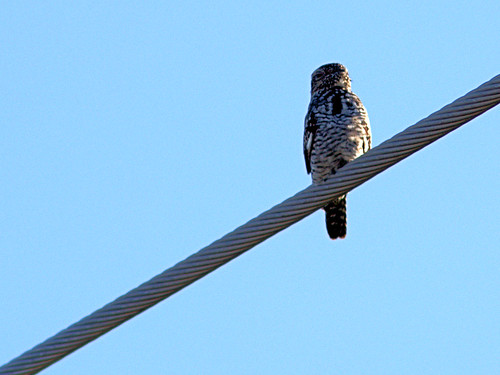
There are usually three or four nighthawk nesting sites along the mile-long gravel course in our wetlands. The birds reveal them by the agitation which builds as we approach. The pair circles us, calling and booming. If someone happens to venture too close to a nest or nestling, the female may attempt to distract the intruder by flying directly towards him/her, then seeming to fall to the ground, with wings flopping and huge mouth open.

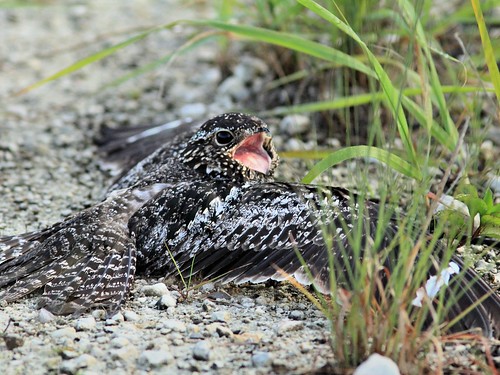

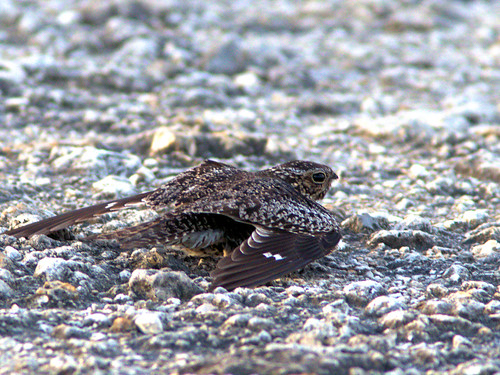
If this happens there may be danger of stepping on eggs, hatchlings or a flightless juvenile bird, as they are remarkably well camouflaged. This nest contains two eggs:
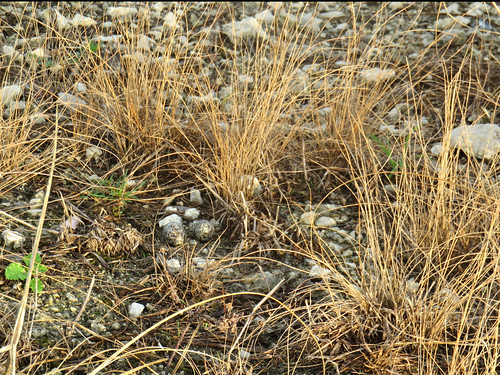
Here is a closer look. The eggs are deposited on bare ground:
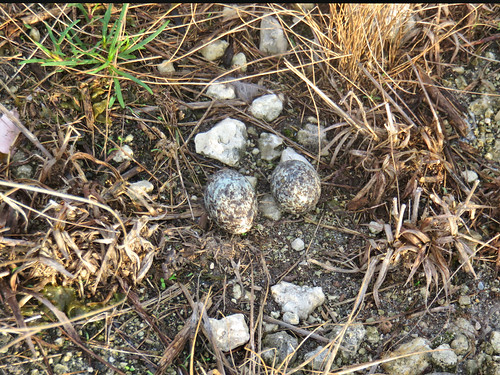
The newly hatched chick can be almost invisible. I almost stepped on this one, located in the middle of the path, before the female warned me of its presence:
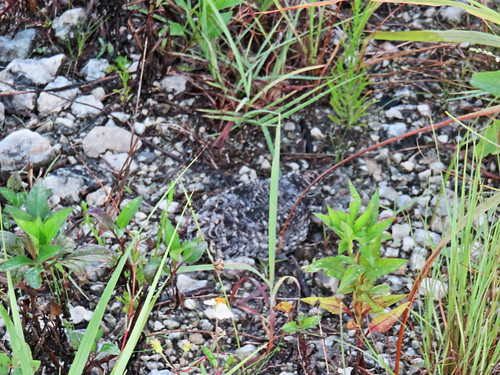
Here is a video of a Common Nighthawk distraction display:
If the video does not display in the space above,
CLICK HERE
Nighthawks are swift and remarkably erratic flyers, executing split-second changes in direction and altitude as they spot prey items, making them extremely difficult subjects for in-flight photography. One trick which I have learned is to keep both eyes open, one looking through the camera viewfinder and the left eye tracking the bird as it zigzags through the sky.This takes some practice as my brain compensates for the parallax between the apparent position of the real bird as compared to its image, similar to the way a heron's brain corrects for parallax which causes a fish to appear nearer and closer to the surface. (Does this mean I have developed a "bird brain?") .
My gallery of processed Common Nighthawk photos numbers over 300, but each of the flight shots represents at least 5-10 times as many attempts-- empty frames of sky and clouds, wing and tail tips, and blurry images. The difficulty is compounded by the poor light conditions. Even with my camera's light sensitivity cranked all the way up (ISO 16,000) and exposure compensation increased to overcome the glare from the sky, I must wait until sunrise for sufficient light, then reduce the ISO as the sky brightens up, allowing the camera to set the exposure, between 1/2000 and 1/3000 second, to stop their movement.
= = = = = = = = = = = = = = =
Linking to Misty's CAMERA CRITTERS,
Linking to Eileen's SATURDAY'S CRITTERS,
Linking to SKYWATCH FRIDAY by Yogi, Sylvia and Sandy
Linking to WEEKEND REFLECTIONS by James
Linking to BirdD'Pot by Anni
Linking to Our World Tuesday by Lady Fi
Linking to Wild Bird Wednesday by Stewart
Linking to Wordless Wednesday (on Tuesday) by NC Sue
Linking to ALL SEASONS by Jesh
________________________________________________
Please visit the links to all these memes to see some excellent photos on display
________________________________________________
Wow what an amazing post, the shots of the Nighthawk are spectacular but so are your sunrise photos. Love all the information that goes with this post and the baby nighthawk is so cute. Thanks for sharing. Diane
ReplyDeleteFantastic post. Very clear and with very good shots.
ReplyDeleteSuch interesting facts and photos about nighthawks. I also enjoyed the video. Their camouflage is amazing
ReplyDeleteBeautiful photos. The nighthawks blend in incredibly well, and I can see how getting stepped on is a very real danger! I like the ground shots.
ReplyDeleteLove all your photography but the sky shots just seem to get better and better as I went through the post. Incredible
ReplyDeleteAmazing shots.
ReplyDeleteThank for sharing such wonderful pictures. Wishing you a wonderful weekend. :)
ReplyDeletehttps://theskygirl.com/2018/07/13/blue-and-gold-skywatchfriday/
Hello, love the sky and moon shots. Great post and photos on the Nighthawk. They are cool birds! Thank so much for linking up and sharing your post. Happy Saturday, enjoy your weekend!
ReplyDeleteWe don't live that far from you so this is a common bird here too. We see it just about every evening. I've never seen it with it's mouth so wide open though. How neat...love the nests too! Enjoy your weekend!
ReplyDeletePS My post last week was about my experience with a 'mad' horsefly getting after me. I wonder if you've ever had this happen to you and what you were able to do about it. I sure hope it never happens again but if it does, I need to be better prepared!
ReplyDeleteAmazing shots! Enjoyed this post so much. I didn't know about knighthawks.
ReplyDeleteInteresting critters. Thanks for the photos and the info.
ReplyDeleteExcellent this week...both in photos & your narration!
ReplyDeleteAlso, I thank you for joining us birding enthusiasts at I'd Rather B Birdin' this week!
Beautifully photographed! Enjoyed seeing the night hawks and the video.
ReplyDeletebesides a beautiful bird or flutterby, nothing beats a colorful, cloudy horizon.
ReplyDeleteWhat a wonderful nighthawk post! I loved every minute of this! Great photos of the male on the wing and the female trying to distract you. And the eggs!
ReplyDeleteYour reflections are top notch! To be honest I'm not sure either about the red writing in my photo. Could be graffiti.
ReplyDeleteBeautiful sky and bird shots! Interesting how the mother watches over and distracts to keep her chick safe!
ReplyDeleteGreat post and outstanding photos. I have never seen a nighthawk before, and appreciate learning about them. Thank you Kenneth!
ReplyDeleteThe underside of the wings of the nighthawk is so interesting that I called hubby to show him! And your moon capture is a wow! Interesting description and video these birds distractions - a total surprise that that they have their eggs on the ground instead of high in a tree! Many thanks for sharing your and Mary Lou's interesting dawn-rise bird explorations with All Seasons! Enjoy your week!
ReplyDeleteAn incredible set of photos. Not just the nighthawk but also the sunrise.
ReplyDeleteSuper post Ken. I was watching our version Caprimulgus europaeus from dusk into the dark just last week.
ReplyDeleteA bird brain, that's funny Kenneth. The storm cloud looks like it has a happy face, ready to do some of its own eating. Its mouth open like the nighthawk.
ReplyDeleteStunning shots.
ReplyDeleteFascinating post and marvelous photos. Thank you - so informative! and thanks, too, for sharing at https://image-in-ing.blogspot.com/2018/07/a-bit-of-avian-whimsey.html
ReplyDeleteAmazing looking bird, its incredible that they are able to camouflage themselves so well, thanks for the share. Hope you have a wonderful rest of your day. Keep up the posts.
ReplyDeleteWorld of Animals
Wonderful post! Sometimes it pays to get up early... or so I gather.
ReplyDelete